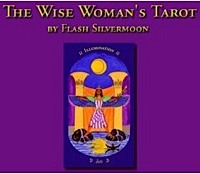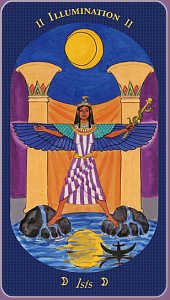By Flash Silvermoon
This is an excerpt from the The Wise Woman's Tarot; a multicultural, matriarchal deck and companion book. Many people believe differently about the origins of Tarot and this is provided only as the view of the author for the purpose of discussion.
The Heritage of the Tarot
Just as the true beginnings of the current human race remain somewhat of a mystery, no one can accurately trace the exact origins of the Tarot. The Tarot was an established tradition within ancient Egyptian culture, so it is not illogical to suspect that these cards pre-date that great culture. My theory on the origins of the Tarot pre-supposes recognition of the one-time existence of the cultures of Atlantis-Lemuria from which all current cultures devolved. These cultures were more advanced in every way than those that followed. But like today’s "advanced civilization" some factions chose to conquer nature, rather than work harmoniously with her. People were advancing (like today) spiritually and technologically, but a growing polarization was occurring simultaneously between those who would use these advancements for constructive ends versus those bent on destructive ends. The wise ones from these countries were aware of the impending danger to their more evolved way of life and encouraged migrations to safer territories. In order to preserve the occult knowledge and traditions of these civilizations, a portable and compact tool with symbols that could span language and cultural barriers had to be devised. What could meet this challenge better than a deck of cards? We will never know what those original decks looked like, but a set of symbols encoded with ancient mysteries is surely the foremother of the modern Tarot.
The Nature of the Tarot
So, what is the Tarot, anyway? The Tarot is an ancient symbolic system presented as a deck of 78 cards, ranging in size from smaller to larger than standard playing cards. The deck is divided into two parts - the Major and Minor Arcana. The Minor Arcana is further divided into 4 suits - Wands, Cups, Pentacles, and Swords - which represent the elements Fire, Water, Earth, and Air, respectively. The Major Arcana deals with archetypal energies such as Strength, Justice, or Transformation. These are broad, abstract, philosophical concepts depicting the macrocosm of the universe, while the more mundane and down to earth affairs of the microcosm are dealt with by the Minor Arcana. Using the Tarot with skill, one can come to a greater understanding of past, present, and future events.
A Tarot reading is done basically by drawing a card or cards from the deck and placing them in certain patterns or layouts. The reader studies the images and meanings of each card and of the cards’ positions and interactions in the layout. From all this input, with a hearty dose of psychic energy, she synthesizes the messages of the reading. I tell my clients that a good reading should feel like a confirmation of their own inner knowing - that is, if they’re fairly conscious. A few surprises and “aha!” experiences are always a nice bonus.
 and created a deck based on a new paradigm! It is for sale with companion book on Flash's website,
and created a deck based on a new paradigm! It is for sale with companion book on Flash's website, 
